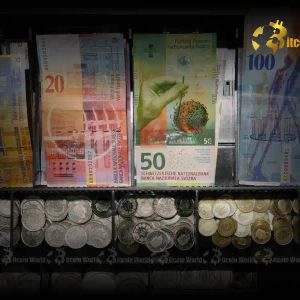Swiss Franc Forecasts: UBS Unveils Alarming Revisions Amid SNB’s Bold Moves
7 min read
BitcoinWorld Swiss Franc Forecasts: UBS Unveils Alarming Revisions Amid SNB’s Bold Moves In the dynamic world of finance, where every market move can send ripples across global portfolios, even traditional currency shifts can signal significant trends for cryptocurrency enthusiasts. Recently, a major player, UBS, delivered a notable update regarding the Swiss Franc , a currency often seen as a bastion of stability. Their revised forecasts, influenced by escalating global uncertainty and decisive actions from the Swiss National Bank (SNB), suggest a period of notable volatility ahead. For those navigating both traditional and digital assets, understanding these shifts is crucial, as they can impact macro-economic outlooks and investor sentiment that spill over into the crypto space. Unpacking the Latest UBS Forecasts : A Paradigm Shift? UBS, a prominent financial institution, has adjusted its outlook for the Swiss Franc , signaling a less optimistic trajectory than previously anticipated. This revision comes at a time when global economic indicators present a mixed picture, and central banks worldwide are recalibrating their monetary policies. The core of UBS’s updated stance revolves around the expected performance of the franc against key major currencies, particularly the Euro (EUR) and the US Dollar (USD). Previous Expectations: Historically, the Swiss Franc has been a preferred safe-haven asset, especially during periods of geopolitical tension or economic downturns. This status often led to expectations of its appreciation or at least resilience. Revised Outlook: UBS now predicts a weakening trend for the franc. For instance, their revised target for EUR/CHF (Euro to Swiss Franc) has been moved upwards, suggesting that it will take more francs to buy one Euro. Similarly, the USD/CHF (US Dollar to Swiss Franc) forecast indicates a strengthening of the dollar against the franc. Why the Change? The adjustment in UBS forecasts is not arbitrary. It reflects a careful assessment of several interconnected factors, including the Swiss National Bank’s recent policy decisions, evolving inflation dynamics, and the broader global risk appetite. This shift highlights how quickly market perceptions can change, even for currencies with a strong historical reputation. How is SNB Action Reshaping the Franc’s Trajectory? The Swiss National Bank (SNB) plays a pivotal role in shaping the value of the Swiss Franc . Its monetary policy decisions, particularly regarding interest rates, directly influence the currency’s attractiveness to international investors. The SNB’s recent move to cut its key interest rate by 25 basis points to 1.50% in March 2024 was a significant development, catching many market participants by surprise. Interest Rate Differential: A lower interest rate in Switzerland compared to other major economies (like the Eurozone or the US) reduces the yield attractiveness of holding Swiss Franc -denominated assets. Investors might opt for currencies offering higher returns, leading to capital outflows from Switzerland and putting downward pressure on the franc. Combating Inflation: The SNB stated that the rate cut was a move to combat persistent inflation pressures. While counterintuitive for some, the SNB believes that the inflationary impulse has waned sufficiently to allow for a more accommodative stance. This proactive measure aims to support the Swiss economy by making borrowing cheaper and stimulating economic activity. Forward Guidance: Beyond the immediate rate cut, the SNB’s forward guidance and communication strategy are equally important. Any hints about future rate cuts or hikes can significantly impact market expectations and, consequently, the franc’s value. The SNB’s willingness to act decisively, even when other central banks remain cautious, underscores its independent approach to monetary policy. This bold SNB action is a primary driver behind UBS’s revised outlook. The Pervasive Influence of Global Uncertainty on Currency Valuations Beyond central bank actions, the broader landscape of global uncertainty continues to cast a long shadow over currency markets, including the Swiss Franc . From geopolitical tensions to fluctuating energy prices and varying economic growth prospects across regions, these factors collectively contribute to market volatility and influence investor sentiment. Geopolitical Risks: Ongoing conflicts, political instability in key regions, and trade disputes can lead investors to seek perceived safe-haven assets. While the Swiss Franc traditionally fulfills this role, persistent uncertainty can also lead to unpredictable capital flows, sometimes favoring the US Dollar over the franc due to its deeper liquidity. Economic Divergence: The differing economic performance and inflation trajectories of major economies create divergence in monetary policies. When the US economy shows stronger growth or higher inflation, the Federal Reserve might maintain higher interest rates, making the USD more attractive than the Swiss Franc . This divergence contributes to the challenges faced by the franc. Commodity Price Volatility: Fluctuations in commodity prices, particularly energy, can impact trade balances and inflation expectations globally. Switzerland, being an import-dependent nation for energy, can see its economic outlook affected by these price swings, indirectly influencing the franc’s strength. Navigating this environment of global uncertainty requires constant vigilance from investors. What Do These Shifts Mean for Broader Currency Markets ? The recalibration of the Swiss Franc ‘s outlook has wider implications for the entire spectrum of currency markets . As one of the world’s most traded currencies, movements in the CHF can trigger ripple effects, influencing trading strategies and investment decisions across various asset classes. Cross-Currency Impact: A weaker Swiss Franc against the Euro or US Dollar can lead to adjustments in other major currency pairs. For instance, if investors are selling CHF, they might be buying EUR or USD, which can strengthen those currencies against others. This creates a chain reaction across the forex landscape. Safe-Haven Dynamics: The traditional safe-haven status of the Swiss Franc is being re-evaluated. If it weakens, investors might increasingly turn to alternatives like gold, the Japanese Yen, or even certain cryptocurrencies perceived as uncorrelated assets, during times of stress. This dynamic shifts the very fabric of how market participants perceive safety. Carry Trade Implications: With lower interest rates, the Swiss Franc becomes more attractive as a funding currency for carry trades. Traders borrow in low-interest-rate currencies (like the CHF) and invest in higher-yielding currencies. This activity can further depress the franc’s value, impacting overall currency markets . Understanding these intricate relationships is key to successful trading. The Future Trajectory of the Swiss Franc : Challenges and Opportunities Ahead The path forward for the Swiss Franc appears to be fraught with both challenges and potential opportunities. While the immediate outlook, as per UBS forecasts , points to weakness, the long-term trajectory will depend on a confluence of domestic and international factors. Investors and market observers should consider several key elements. SNB’s Future Stance: The Swiss National Bank’s future monetary policy decisions will be paramount. Will they continue with rate cuts, or will inflation concerns resurface, prompting a more hawkish pivot? The SNB’s responsiveness to economic data will be critical. Global Economic Health: The health of the global economy, particularly the Eurozone and the US, will directly influence demand for Swiss exports and investor confidence in the region. A robust global recovery could indirectly support the franc, while a downturn could exacerbate its weakening trend. Inflationary Pressures: While the SNB has indicated waning inflation, a resurgence of price pressures, either domestically or imported, could force the central bank to reconsider its accommodative stance. This would introduce significant volatility for the Swiss Franc . Geopolitical Stability: Continued geopolitical stability, or conversely, an escalation of conflicts, will shape risk sentiment and demand for safe-haven assets. The Swiss Franc ‘s role in this dynamic will evolve based on the prevailing global environment. Actionable Insights for Investors: Given the revised outlook for the Swiss Franc and the prevailing global uncertainty , what can investors do to navigate these turbulent waters? Here are some actionable insights: Diversify Your Portfolio: Do not put all your eggs in one basket. Consider diversifying across different asset classes, including a mix of traditional currencies, commodities, and potentially digital assets, to mitigate risks associated with single-currency exposure. Monitor Central Bank Communications: Pay close attention to statements and minutes from the Swiss National Bank (SNB), the European Central Bank (ECB), and the Federal Reserve (Fed). Their forward guidance provides crucial clues about future monetary policy. Stay Informed on Geopolitics: Geopolitical events can trigger rapid shifts in currency markets . Keeping abreast of international developments will help you anticipate potential market reactions. Re-evaluate Safe-Haven Strategies: If the Swiss Franc ‘s safe-haven status is diminishing, explore alternative assets that offer stability during market downturns. This could include gold, or for some, specific cryptocurrencies known for their stability or store-of-value properties. Consider Hedging Strategies: For businesses or individuals with significant exposure to the Swiss Franc , explore hedging options to protect against adverse currency movements. The recent adjustments in UBS forecasts for the Swiss Franc underscore the complex interplay of central bank actions, such as the decisive SNB action , and the broader environment of persistent global uncertainty . These factors are reshaping perceptions and valuations within currency markets . While the franc faces headwinds, particularly from interest rate differentials and a shifting safe-haven landscape, its future remains tied to both domestic economic resilience and the evolving global financial climate. For investors, understanding these dynamics is not just about predicting currency movements; it’s about adapting strategies to protect and grow wealth in an increasingly interconnected and unpredictable world. The story of the Swiss Franc serves as a potent reminder that even the most stable currencies are subject to the relentless forces of global finance. To learn more about the latest Forex market trends, explore our article on key developments shaping global liquidity and institutional adoption. This post Swiss Franc Forecasts: UBS Unveils Alarming Revisions Amid SNB’s Bold Moves first appeared on BitcoinWorld and is written by Editorial Team

Source: Bitcoin World



